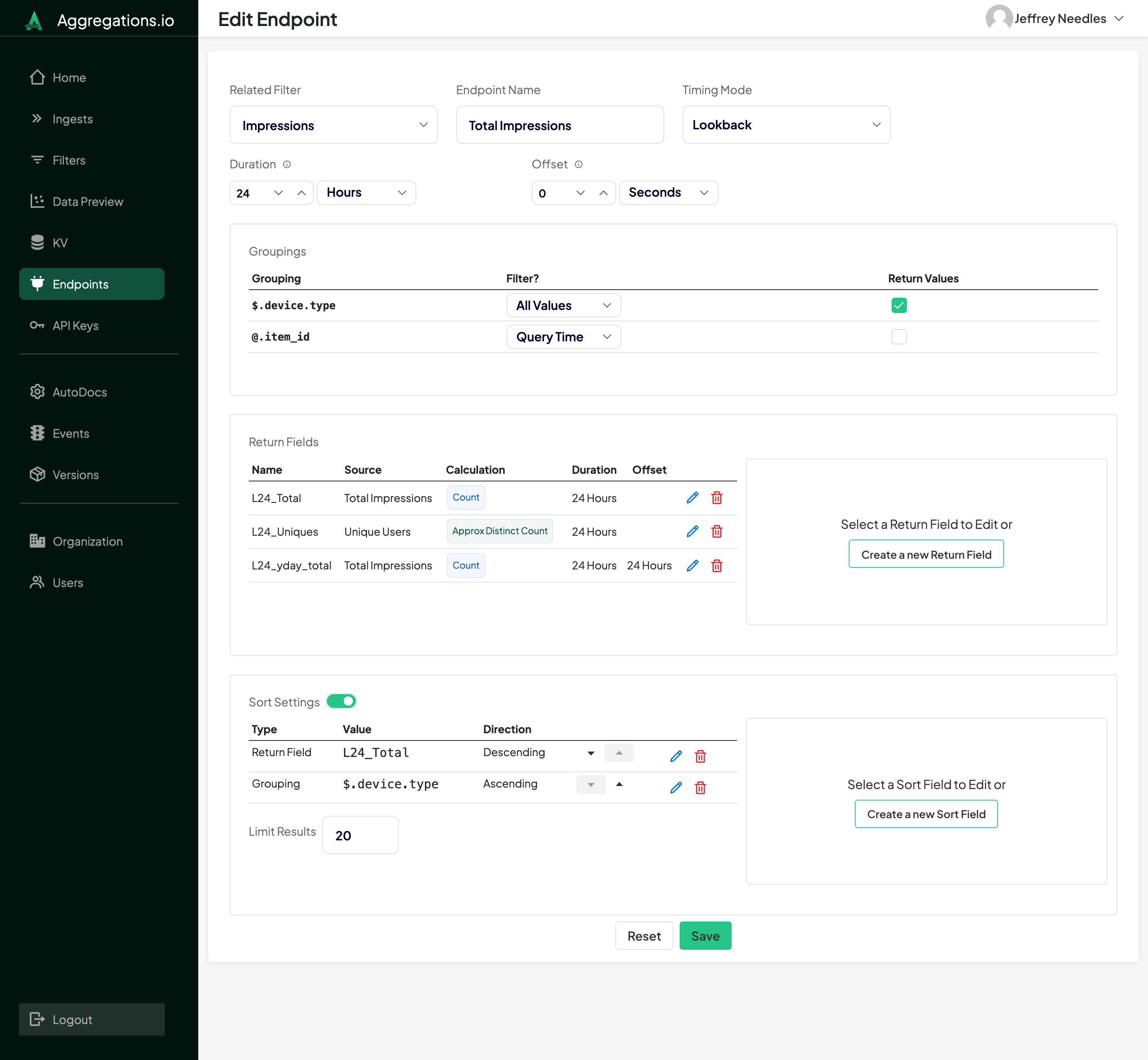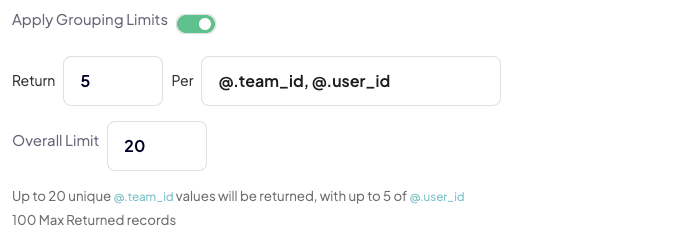#
Endpoints
Endpoints make it easy to incorporate your Aggregations data into your product, analytics or BI workflow. Building on top of Filters and the Metrics API, you can control (in the UI) what information you'll return without needing to understand all the intricacies of the API.
#
Creating an Endpoint
An Endpoint has five key components:
#
Related Filter
Choose one of your filters to retrieve results for. You can create multiple endpoints referring to the same filter, in order to mix and match groupings, time periods, etc.
Changing Your Filter
When your endpoint is linked to a filter, changing your filter's definition may impact the results of your endpoint.
Be sure to read the
#
Timing
Your endpoint can either be a Lookback or a Time Series.
#
Lookback
A Lookback will show you aggregate results over a period of time.
#
Duration
Choose a duration that is greater than or equal to the interval of your source filter. It is best to keep duration a multiple of your source interval.
For example, if your source interval is 60 minutes, a 90 minute duration will never contain more than 60 minutes worth of data. If you want a 90 minute duration sometimes and a 60 minute duration other times, it'd be best to set your filter up at 30 minutes.
See more about how duration calculations work
#
Offset
When retrieving the results for your endpoint, the default behavior is to start from now. You can instead define a buffer window or consistent offset to apply to all requests.
#
Include Incomplete Intervals?
Decide whether you want "incomplete" data to be included in your lookback (default ON).
If your underlying filter has an hourly interval, and you query at 30 minutes past the hour:
With this setting ON those 30 minutes will be included in your results.
With this setting OFF those 30 minutes will not be included in your results, and your query will be shifted back 30 minutes, to ensure you still have a full duration.
#
Time Series
A Time Series endpoint allows you to retrieve results at a specified interval.
#
Time Series Interval
You can opt to override your source filter's interval, it just needs to be longer than the source's interval.
#
Duration
Duration for a Time Series endpoint dictates how far back you'll go to get data points. Your duration must be greater than your interval.
#
Offset
When retrieving the results for your endpoint, the default behavior is to start from now. You can instead define a buffer window or consistent offset to apply to all requests.
#
Include Incomplete Intervals?
Decide whether you want "incomplete" data to be included in your Time Series (default OFF).
If endpoint interval is hourly (either due to override or the underlying filter) and you query at 30 minutes past the hour:
With this setting ON those 30 minutes will be included in your results.
With this setting OFF those 30 minutes will not be included in your results, and your query will be shifted back 30 minutes, to ensure you still have a full duration.
#
Groupings
If your source filter has groupings specified, the Groupings panel controls how/if they are returned when querying your endpoint.
You'll see each of your filter's groupings defined with an option to filter them or aggregate them.
Your choices are:
New Groupings
If you add a new grouping to your filter, the default behavior for any associated endpoint will be to Aggregate them into existing grouping choices.
#
Return Fields
Return Fields let you choose the Aggregations & Calculations that will be returned in your result set.
#
Creating a new Return Field
A Return field consists of:
- Name
- The name should help you understand that that data represents. This name is used as a key in the resulting JSON payload, so it is important to have it be "system friendly" as well.
- Source
- Choose the aggregation on your source filter to calculate.
- Calculation
- Choose which calculation assigned to your aggregation to calculate.
- Percentile
- If you choose a
PERCENTILEScalculation, you need to choose the percentile value (0-1). - Advanced Time Settings
- When creating a Lookback endpoint, you can override the duration, offset and incomplete interval handling.
#
Sort Settings
By default, you will retrieve 1000 items from your endpoint (for Lookbacks).
You can enable sorting to have more fine-grained control over how much data you retrieve and the order they are returned in.
Time Series Sorting
Time Series endpoints will always be sorted in descending order time. Sorting controls how any groupings included in your return are ordered.
#
Adding a Sort Field
When you add a new sort field, you can choose whether you're sorting by an unused grouping or return field in ascending or descending order.
#
Grouping Limits
When you have multiple groupings defined, you can limit the number of inner grouping items that are returned, as well as the overall number of root items.
For example, if you want to display a leaderboard and have it representative of the top 5 players per team, you could group by player & team, set your grouping limits to:
#
Querying Endpoints
Endpoints are accessed by POSTing a JSON payload to https://app.aggregations.io/api/v1/data/{id}
Authentication
All requests must be accompanied by an x-api-token header with an API Key having read permissions.
#
Request Parameters
Parameters for your request include:
#
Response Format
JSON Responses will include the following properties:
CSV Responses will include a header row and the order of columns will be:
dtif it is a Time Series endpoint- One column per grouping that is set to return a value, ordered by the order in your source filter.
- One column per return field
#
Example Requests/Responses
Request:
{}Response
[
{
"groupings": {
"@.grp1": "Grouping1",
"@.grp2": "Grouping2"
},
"fields": {
"field_1": 123,
"field_2": 22.33
}
}
...
]Request:
{
"format": "CSV"
}Response:
@.grp1,@.grp2,field_1,field_2
Grouping1,Grouping2,123,22.33Request:
{
"groupingFilters": {
"@.grp1": ["GroupingValueIWant1", "GroupingValueIWant2"]
}
}Response:
[
{
"groupings": {
"@.grp1": "GroupingValueIWant1"
},
"fields": {
"field_1": 333
}
},
{
"groupings": {
"@.grp1": "GroupingValueIWant2"
},
"fields": {
"field_1": -100.7
}
}
]
#
Considerations
#
Filter Changes
Some changes to your filter are "safe" and others are not, so they are not allowed.
#
Removing/Renaming a Grouping
If you remove a grouping from your filter that had Return Value enabled, your existing groupings will return, but all values going forward will be empty.

When you return to edit your Endpoint, you will notice the grouping is disabled and a message informs you that if you save, the grouping will no longer be returned in your endpoint response.
#
Removing an Aggregation or Calculation
If you attempt to remove an aggregation (or a calculation in use on a field) you may be blocked from saving your filter change. This will happen if it is the only or last valid return field on an endpoint.
If you have other valid fields remaining on your endpoint, you'll be able to save - and any now invalid fields values will return null.
When you return to the edit your Endpoint, you will see the invalid return fields highlighted, and you'll need to edit or remove it befoe saving.
#
Modifying your Interval
If your filter's interval becomes more frequent (ie: changing from daily to hourly) and you've created a Lookback endpoint, there is likely no impact.
If your filter's interval becomes more frequent (ie: changing from daily to hourly) and you're using a Time Series endpoint without overriding the Time Series Interval - your endpoint will return values at the newly defined interval.
If your filter's interval becomes less frequent (ie: changing from hourly to daily) you run the risk of losing correctness on your Endpoint.
It is not advisable to modify your filter's interval in this way.
You should ensure you update your Endpoint's duration(s) before modifying the source filter.
#
Duration Calculations
The duration and offset concepts are best explained by example.
Let's assume we have ingested events with the values below:
Your underlying Filter is set to an interval of 2 Minutes
It is currently 2025-01-01 12:07:00
#
Scenarios:
- Lookback endpoint with a 4 minute duration, Include Incomplete Intervals =
ON- Total = 103
- Lookback endpoint with a 3 minute duration, Include Incomplete Intervals =
OFF- Total = 3
- Because
3is not a multiple of the underlying interval and Include Incomplete Intervals is disabled, only the data point at2025-01-01 12:04:00is retrieved.
- Lookback endpoint with a 6 minute duration, Include Incomplete Intervals =
ON- Total = 113
- Lookabck endpoint with a 6 minute duration, Include Incomplete Intervals =
OFF, 1 minute offset- Total = 34
- Lookabck endpoint with a 6 minute duration, Include Incomplete Intervals =
OFF, 1 minute offset,endspecified in query as2025-01-01 12:04:00- Total = 21


